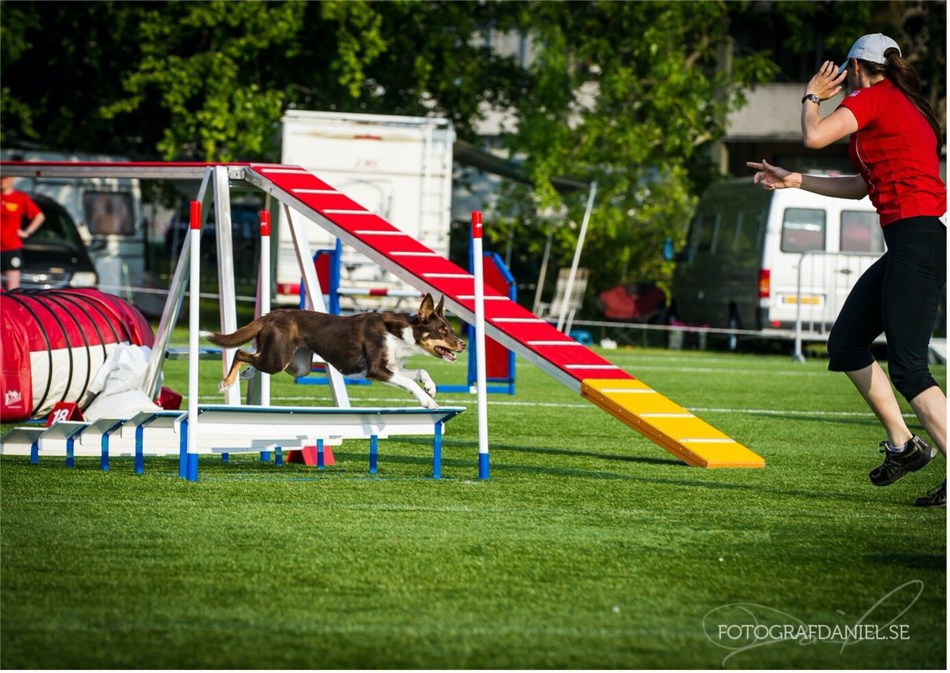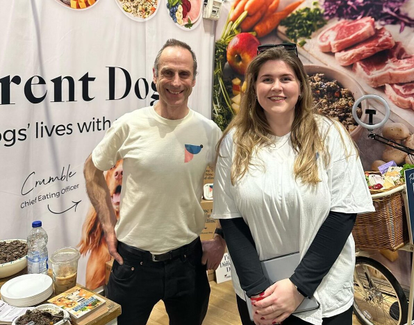Would my dog enjoy agility?

Bonny Quick is an agility superstar and Different Dog ambassador. With many international British medals under her belt, she has taken the agility scene by storm. Whether you’re an aspiring agility trainer or just looking for a fun activity to do with your dog, Bonny shares her experience of getting into the sport and how you can too.

How to get into agility with your dog
Have you ever settled down on the sofa only to find your dog’s eyes staring at you as if to say, “what’s next?” If even a good, long walk seems to leave your dog ready-for-action, a great activity to explore together might be… agility.
I started agility with my black Labrador. I remember looking at her and thinking she needed some more fun in her life! We popped along to a small, local training centre one evening and had a go. There were treats involved, which she’s of course a sucker for so that already went down well. It was really fun working so closely together, as I learned how to teach her new skills. When we came home from our first evening of agility, she was tired in a way she just wasn’t from our daily walks.
What is dog agility?
Agility is an activity in which dog and handler complete a number of obstacles in a sequence, with the aim of doing it cleanly in as fast a time as possible. Don’t worry, it’s only the dog doing the obstacles! The handler’s job is to act like a sat nav, directing the dog on where to go next, since each sequence has a unique arrangement. The dog, meanwhile, is tasked with jumping over jumps, racing through tunnels, bending his way through the weaves and speeding over the off-the-ground equipment such as the A-frame and see-saw.
During agility training, your dog will get to learn all sorts of new skills – engaging both his brain and his body. Plus, he’ll be hanging out with other dogs and you’ll get a chance to meet like-minded dog-lovers.
There’s loads to learn in agility. For example, did you know that when the dog goes through the weave poles he always has to start with the first pole on his left side? Or that a competition sequence can be anywhere from 16 to 20 obstacles long?
There are exciting handling manoeuvres to learn too, such as a front or blind cross, which are both ways of getting your dog from one side of you to the other, or a ketschker, which is a move you can do on a jump to encourage your dog to turn tightly around the jump wing.
Gradually, my Labrador and I got more and more hooked on agility. She would get excited on the drive there and when she figured out where we were headed I’d hear her letting out tiny little whines in the car! We started to make friends at the club and eventually, I was talked into doing a competition.
Competitions sound serious, but are actually a whole lot of fun. At a competition, you get set a sequence by the judge. The first time you see that sequence will be when you “walk the course”. You do this with the other handlers, without your dogs and are figuring out how to navigate your dog around the course as efficiently as possible. There is often a bit of strategy involved, for example there might be a few different route variations to choose from.

Once it’s your turn, you head to the start line and after getting the all-clear to begin, it’s game-on! Most sequences take around 25 to 40 seconds to complete, so it all happens really quickly. You’re aiming for a clear round, but if your dog knocks a pole or misses a weave entry you’ll pick up faults. If your dog goes the wrong way – such as heading into the wrong end of the tunnel – it’s called an elimination, and when this happens the judge will usually make an X sign with their hands.
Crufts is an ideal opportunity to watch some fabulous agility as many of the best dog and handler partnerships in the country will be there. If you aren’t going in person, it’s worth keeping an eye out for it on TV, as Crufts highlights are shown on Channel 4. The rest is screened live on the Kennel Club’s Crufts channel on YouTube.
This year, I’m really excited to be competing again at Crufts with my Jack Russell cross Border Collie Shelley. We are taking part in the British Open and Championship events on Thursday. It’s a massive thrill competing at Crufts, the atmosphere is always buzzing! Shelley (posh name: “Agility Champion Goldheart Trail of Flames”) absolutely loves running on the green carpet. A few years ago, we won the British Open. It was a really happy time as I had given birth to my first child just a few weeks beforehand.
You’ll see all sorts of dogs doing agility at Crufts, and that’s because it’s a great activity for so many pets. Dogs of all sizes can take part, from tiny Papillons through to large Malinois. It doesn’t matter whether your dog is pedigree or not, as there’s no distinction in agility. So long as your dog is reasonably fit and healthy, free from back conditions and a reasonable weight, the chances are he’ll enjoy agility.

Will my dog be able to learn agility?
Before starting agility, it’s useful to make sure your dog has a few life skills. He needs to know to come back to you when you call him off lead. I constantly “add value” to this behaviour so I pair something good happening with my dog coming to me when I call. This could be giving her a treat or playing a game with her after I call.
It's also useful pre-agility to teach your dog how to wait – in other words, how to stay still until you tell him to move. A great time to teach this is at Different Dog mealtimes, because he’ll be keen to get to his food! The trick is to get your dog used to staying still while you put his food down, by raising it up if he goes straight towards it. When he stops trying to move forward, put his food down and then use a word such as “go” to tell him the wait game is over.
Agility trainers are used to teaching all sorts of different partnerships. I train agility full time around the country and my classes have included a diverse range of people, from children to handlers in their eighties. Border collies and cocker spaniels are very common in agility at the moment, but there are Yorkshire Terriers, Miniature Pinschers and Shetland Sheepdogs…and the list goes on.
So, what are you waiting for?
The best way to start out in agility is to join up for classes or a spot of one-on-one training somewhere local to you. Find your nearest location here: https://agilitynet.co.uk/clutch/clubs.htm
Bonny Quick’s book on agility, the Agility Bible is available here.


Join The Pack
Receive exclusive offers, tips and tricks from our vet.

